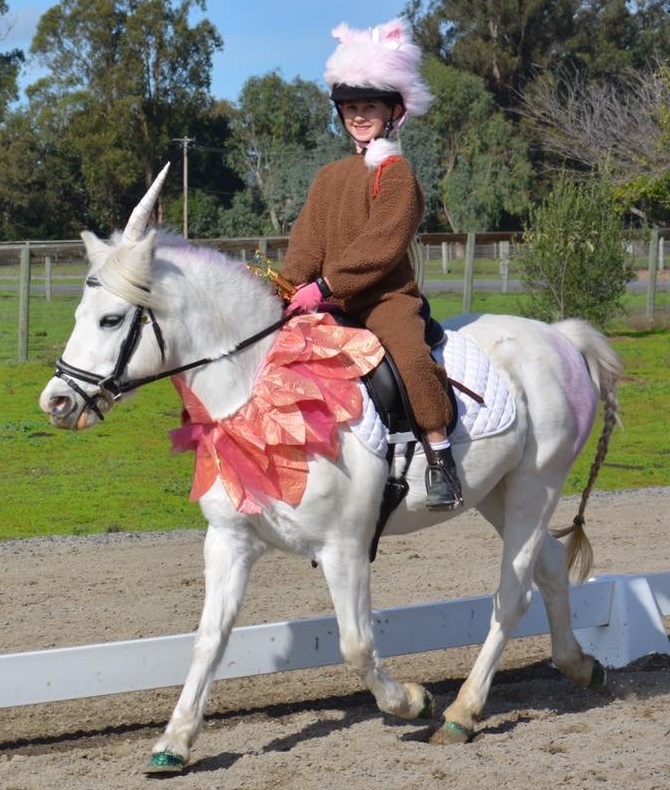Battling EMS and PPID - Miss Gwen’s Road To Recovery
 At 21 years young, Miss Gwen is every horse crazy girl’s dream - a beautiful grey pony with a long forelock perfect for braiding. Gwen and her owner, Ainsely Davis, have a great time competing in shows, dressing up, and going on riding adventures. Today, Gwen is happy and healthy, but she and her family had to fight their way down a difficult road and find the right balance to manage not one, but two endocrine diseases, pituitary pars intermedia dysfunction (PPID) and equine metabolic syndrome (EMS).
At 21 years young, Miss Gwen is every horse crazy girl’s dream - a beautiful grey pony with a long forelock perfect for braiding. Gwen and her owner, Ainsely Davis, have a great time competing in shows, dressing up, and going on riding adventures. Today, Gwen is happy and healthy, but she and her family had to fight their way down a difficult road and find the right balance to manage not one, but two endocrine diseases, pituitary pars intermedia dysfunction (PPID) and equine metabolic syndrome (EMS).
The endocrine system is comprised of glands that produce hormones that then travel through the bloodstream to different tissues in the body. The hormones signal the tissues to perform various functions related to respiration, metabolism, development, growth, and more. These hormones are also part of feedback loops which tell the glands to increase or decrease hormone production depending on the body’s needs at a given time. Endocrine diseases result in interruptions in these loops and often lead to disruptions in essential body functions. In humans, these interruptions can cause Type 1 and 2 diabetes, over and underactive thyroid (hyperthyroidism and hypothyroidism, respectively), Addison’s disease, and more.
 For Gwen, what first started out as mild foot soreness on gravel roads evolved into foot soreness in soft arena footing, prompting a visit with her veterinarian. She was diagnosed with PPID (also known as Cushing’s disease). This disease is associated with aging and affects hormones produced by the pituitary gland (see story “Separate but Connected” in this issue for more). Gwen started treatment, which included the medication pergolide and dietary management. Unfortunately, she became extremely footsore to the point that she significantly shifted her weight onto her hindquarters. Her family decided to bring her to the UC Davis veterinary hospital.
For Gwen, what first started out as mild foot soreness on gravel roads evolved into foot soreness in soft arena footing, prompting a visit with her veterinarian. She was diagnosed with PPID (also known as Cushing’s disease). This disease is associated with aging and affects hormones produced by the pituitary gland (see story “Separate but Connected” in this issue for more). Gwen started treatment, which included the medication pergolide and dietary management. Unfortunately, she became extremely footsore to the point that she significantly shifted her weight onto her hindquarters. Her family decided to bring her to the UC Davis veterinary hospital.
In addition to PPID, UC Davis clinicians also diagnosed Gwen with another endocrine disease, EMS, which is associated with inappropriate blood insulin levels (see story “Separate but Connected” in this issue for more), similar to how type 2 diabetes in humans leads to insulin resistance. X-rays revealed laminitis (inflammation and damage of the tissue between the hoof and the underlying coffin bone) of both front feet due to these diseases.
“I prepared my daughter for what I thought was to come, us losing Gwen,” said Ainsley’s mom, Margaret. “I truly didn’t think she would ever come home again.”
Fortunately, Gwen responded well to medication and therapeutic approaches.
“Gwen is a very special pony, and her owners took recommendations to manage her metabolic syndrome and laminitis to heart,” said Dr. Emily Berryhill, assistant professor of Medicine and Epidemiology at the UC Davis School of Veterinary Medicine and a clinician with the UC Davis veterinary hospital’s Equine Internal Medicine Service.
The first steps to managing Gwen’s conditions were to test batches of hay and read labels on grains in order to find an appropriate feed with low non-structural carbohydrate (sugar) content. Gwen was placed on a supplement to increase her metabolism and help her lose weight quickly since her feet were too sore for exercise. Medications helped decrease the amount of sugar absorbed from her intestines and kidneys and reduce the pain associated with her fluctuating laminitis flare-ups. Her referring veterinarians monitored her insulin concentrations often to gauge her response to the different therapies. Gwen also had frequent and consistent visits with Shane Westman, the UC Davis veterinary hospital’s farrier, who tried a variety of different therapeutic shoes to provide mechanical support for Gwen’s fragile feet and improve her comfort.
 The process of finding the right balance of medications, dietary management, and farrier care was vital to Gwen’s recovery, but it did not happen overnight.
The process of finding the right balance of medications, dietary management, and farrier care was vital to Gwen’s recovery, but it did not happen overnight.
“Gwen became a favorite patient to all at the veterinary hospital, as it took months and many visits to find the combination of medications to control Gwen’s metabolic disease and for Gwen’s feet to stabilize,” said Berryhill. “Gwen and her owners were troopers through it all, and we are so glad she is a happy and comfortable pony again.”
Gwen’s owners recognize that the combination of a strict, low sugar, low carbohydrate feed, medications, and farrier care saved her life. They are happy to report that “today Gwen is totally sound, bright eyed, and the beautiful, sweet pony we have always loved.”
